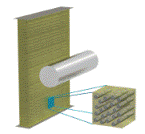Mechanical & Materials Engineering, Department of
Date of this Version
12-2009
Abstract
Polycarbonate(PC), like most glassy polymers when undergoing large deformations exhibits a very complex thermo-mechanical response. We look at PC as a model glassy polymer and examine its response to changes in loading rate, loading direction and temperature. We show that plastic flow in compression is accompanied by a change in the elastic response of PC from isotropic to anisotropic. This provides the necessity to introduce a new modeling method that can capture these changes. A finite deformation plasticity like thermodynamically consistent model is developed to capture this and the observed rate and temperature dependence. For this modeling method, we need to provide expressions for the elastic response, flow of the plastic deformation gradient and also provide methods to calculate the back stress. In an effort to mathematically capture the observed response of PC under a broad range of mechanical loads and thermal conditions, a protocol of experiments has been developed that can be used to systematically evaluate the parameters needed to characterize PC, and with potential for application to other glassy polymers. This experimental protocol combines traditional mechanical testing, ultrasonic wave speed measurements, dynamic kolsky bar methods and standard calorimetric studies to systematically construct a model for PC.
Polycarbonate (PC) is a tough transparent glassy polymer that is used for many structural applications, particularly as components of window and protective armor. Below its glass transition temperature of about 150°C, PC plastically flows under load, showing a rate dependent response and will not fully recover after removal of load, showing elements of plastic flow. As a result, the response of PC has been modeled using a rate dependent type model. When plastically deformed below the glass transition temperature, unlike PMMA, which is also a glassy polymer, PC will show very strong anisotropic elastic response. This can be seen from ultrasonic measurement of elastic wave-speed moduli after different levels of plastic compression. This is the first indication that traditional modeling methods based on plasticity will not work for capturing the response of PC if they are based on stress response models that only depend on the elastic deformation gradient. One needs to include additional history defining parameters in the stress response function, such as the plastic deformation gradient, to capture this development of anisotropy with plastic flow.


Comments
A DISSERTATION Presented to the Faculty of The Graduate College at the University of Nebraska In Partial Fulfillment of Requirements For the Degree of Doctor of Philosophy, Major: Engineering; Under the Supervision of Professor Mehrdad Negahban
Lincoln, Nebraska: December, 2009
Copyright (c) 2009 Ashwani Kumar Goel